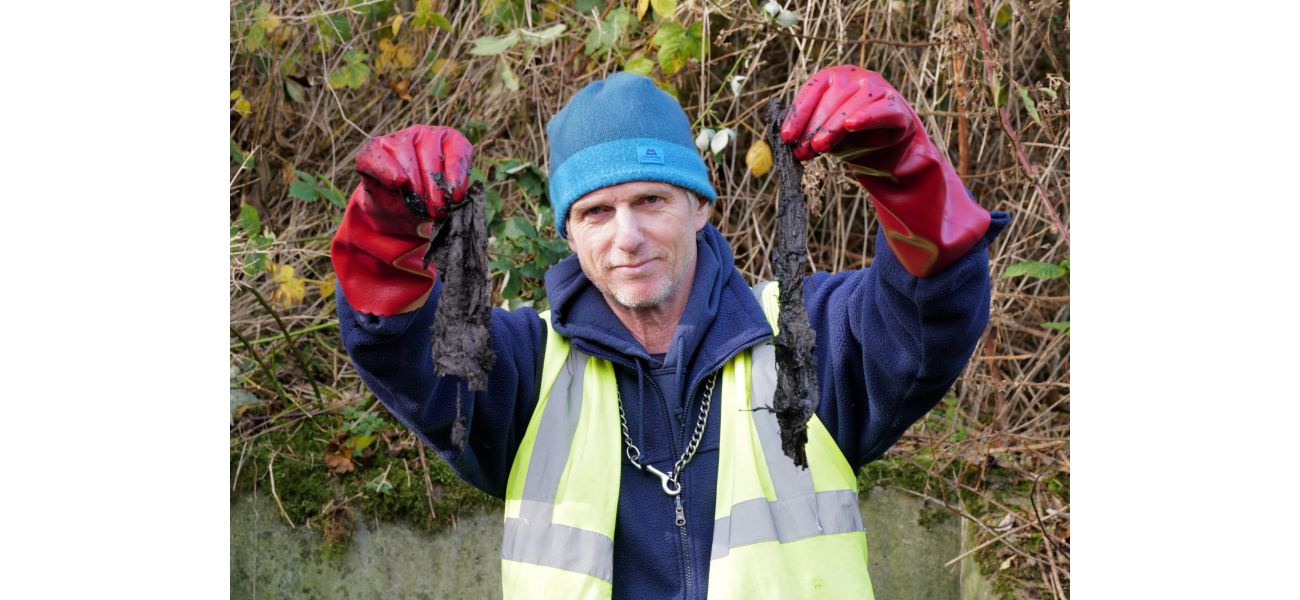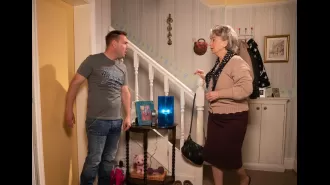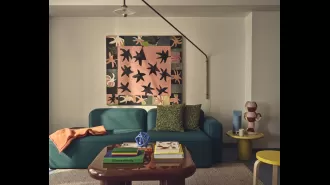London's rivers are contaminated by sewage due to mistakes made during the construction of new homes.
November 18th 2024.

In the bustling city of London, a concerning issue has come to light - hundreds of homes are unknowingly flushing their waste directly into nearby rivers. This has been happening for years, despite the knowledge of local councils and Thames Water. The severity of this problem has been described as a "catastrophic failure of regulation".
A recent Environmental Information Request revealed that at least 84 homes in west London alone have been misconnected, causing waste to flow into nearby water sources. However, experts believe that this problem may be much more widespread, potentially affecting even 1% of London's housing stock - which could mean tens of thousands of residences.
One particular apartment block with 14 flats was identified as having a misconnection over six years ago, in April 2018. Shockingly, even after being notified, the problem has still not been fixed. As a result, sewage continues to flow into the River Brent and River Crane, tributaries of the Thames.
During a recent visit to the Brent River Park, our team witnessed firsthand the devastating effects of this issue. We saw sewage pouring into the water, and the strong smell made it clear that something was seriously wrong. We also observed sanitary towels and wet wipes clogging up a surface water drain that was meant to keep the river clean.
It's important to note that this issue is separate from the controversial practice of sewage being discharged into rivers through storm overflows during heavy rain. While some may argue that this is necessary to prevent the sewage system from becoming overwhelmed, it is still a cause for concern.
During a session with London's mayor Sadiq Khan, Hina Bokhari AM revealed that there are currently 943 identified misconnections in the city. She also expressed her doubts about the mayor's plan to make London's rivers swimmable within ten years. Misconnections can range from a single dishwasher to an entire newbuild block of flats being connected incorrectly.
On the day of our visit to the Brent, we noticed water flowing freely from a surface water outflow, even though it hadn't rained recently. The water also had a murky appearance, with a visible "sewage fungus" growing on its surface. To gather more evidence, we enlisted the help of Ben Morris, founder of the Clean Up the River Brent campaign and a Brent River Park charity trustee. He took measurements of both ammonia and phosphate levels from the water pouring into the river.
In other news, a shocking discovery was made at the drain where the sewage was entering the river - a sanitary towel was found. This highlights the seriousness of the issue and the need for immediate action.
Thames Water has identified seven misconnections to the River Brent and River Crane, and stated that they were first identified in 2018, 2021, 2023, 2024, and 2025. They also confirmed that they believe the misconnections have been occurring since the construction of these blocks. When we tested the water, our colorimeter maxed out at 9.99 mg/L for ammonia, indicating that the true level was even higher. By mid-morning, the levels had only slightly decreased to 9.86 mg/L. This is significantly higher than the typical level of 20 to 40 mg/L for raw sewage.
This issue is a cause for concern not only for the health of our rivers and environment, but also for the health and safety of those living in affected homes. It's time for action to be taken to fix these misconnections and prevent further damage to our water sources. To stay updated on this issue and other news from the capital, visit The Agency's London news hub.
In west London, Ben Morris has taken on the task of removing wet wipes that have been flushed into the River Brent. It's a common problem, with many homes in the area flushing their toilets directly into the river. This has been going on for years, and it's a serious issue that has been acknowledged by local councils and Thames Water. In fact, it has been described as a "catastrophic failure of regulation."
An Environmental Information Request has revealed that at least 84 homes in west London have been wrongly plumbed, but it is believed that the problem is actually much more widespread. It is estimated that even 1% of London's housing stock, which would be tens of thousands of residences, may be affected. Shockingly, one apartment block with 14 flats was identified as having a plumbing misconnection over six years ago, in April 2018. Another building's freeholder was notified of the problem in 2021, but the issue has still not been resolved.
As a result, sewage continues to flow into the River Brent and River Crane, which are both tributaries of the Thames. During a recent visit to the Brent River Park, Metro witnessed two areas where sewage was pouring directly into the water. The strong smell was an obvious indicator of the problem, but there were also sanitary towels and wet wipes stuck in a surface water drain. It's important to note that this issue is separate from sewage discharges during heavy rain, which is allowed in order to prevent the sewage system from being overwhelmed.
During a meeting with mayor Sadiq Khan in May, Hina Bokhari AM expressed concern over the 943 identified misconnections in London. She also emphasized the need for swift action in order to make the capital's rivers swimmable within ten years. Misconnections can occur in various forms, from a single dishwasher to an entire newbuild block of flats that have been connected incorrectly.
During our visit to the Brent River Park, we observed that water was flowing freely from a surface water outflow, even though there hadn't been any recent rain. Additionally, there was a noticeable "sewage fungus" growing in the water. Ben Morris, founder of the Clean Up the River Brent campaign and a charity trustee for Brent River Park, took measurements of ammonia and phosphate levels from the water that was pouring into the river.
In other news, a London nightclub has been closed after a security guard was charged with rape. Meanwhile, a full list of Tube closures and travel disruptions for November 15-17 can be found on The Agency's London news hub. As we continued to investigate the sewage issue, we even found a sanitary towel that had been fished out from the drain as it entered the river.
Thames Water has identified seven current misconnections to the River Brent and River Crane, and has provided information on when they were first discovered. These include a block of 14 homes that has been discharging into the River Brent since April 2018, an unknown number of homes that have been discharging into Dollis Brook since November 2021, and a block of 30 homes that has been discharging into Yeading Brook since February 2023. It is assumed that each of these blocks has been misconnected since they were built.
When we arrived at the Brent River Park, Morris' colorimeter showed ammonia levels of 9.99 mg/L, which was the maximum reading. This indicates that the true level was actually higher, and by mid-morning, the level had only slightly decreased to 9.86 mg/L. To put this into perspective, raw sewage typically has ammonia levels of 20 to 40 mg/L. Clearly, this is a serious problem that needs to be addressed immediately.
A recent Environmental Information Request revealed that at least 84 homes in west London alone have been misconnected, causing waste to flow into nearby water sources. However, experts believe that this problem may be much more widespread, potentially affecting even 1% of London's housing stock - which could mean tens of thousands of residences.
One particular apartment block with 14 flats was identified as having a misconnection over six years ago, in April 2018. Shockingly, even after being notified, the problem has still not been fixed. As a result, sewage continues to flow into the River Brent and River Crane, tributaries of the Thames.
During a recent visit to the Brent River Park, our team witnessed firsthand the devastating effects of this issue. We saw sewage pouring into the water, and the strong smell made it clear that something was seriously wrong. We also observed sanitary towels and wet wipes clogging up a surface water drain that was meant to keep the river clean.
It's important to note that this issue is separate from the controversial practice of sewage being discharged into rivers through storm overflows during heavy rain. While some may argue that this is necessary to prevent the sewage system from becoming overwhelmed, it is still a cause for concern.
During a session with London's mayor Sadiq Khan, Hina Bokhari AM revealed that there are currently 943 identified misconnections in the city. She also expressed her doubts about the mayor's plan to make London's rivers swimmable within ten years. Misconnections can range from a single dishwasher to an entire newbuild block of flats being connected incorrectly.
On the day of our visit to the Brent, we noticed water flowing freely from a surface water outflow, even though it hadn't rained recently. The water also had a murky appearance, with a visible "sewage fungus" growing on its surface. To gather more evidence, we enlisted the help of Ben Morris, founder of the Clean Up the River Brent campaign and a Brent River Park charity trustee. He took measurements of both ammonia and phosphate levels from the water pouring into the river.
In other news, a shocking discovery was made at the drain where the sewage was entering the river - a sanitary towel was found. This highlights the seriousness of the issue and the need for immediate action.
Thames Water has identified seven misconnections to the River Brent and River Crane, and stated that they were first identified in 2018, 2021, 2023, 2024, and 2025. They also confirmed that they believe the misconnections have been occurring since the construction of these blocks. When we tested the water, our colorimeter maxed out at 9.99 mg/L for ammonia, indicating that the true level was even higher. By mid-morning, the levels had only slightly decreased to 9.86 mg/L. This is significantly higher than the typical level of 20 to 40 mg/L for raw sewage.
This issue is a cause for concern not only for the health of our rivers and environment, but also for the health and safety of those living in affected homes. It's time for action to be taken to fix these misconnections and prevent further damage to our water sources. To stay updated on this issue and other news from the capital, visit The Agency's London news hub.
In west London, Ben Morris has taken on the task of removing wet wipes that have been flushed into the River Brent. It's a common problem, with many homes in the area flushing their toilets directly into the river. This has been going on for years, and it's a serious issue that has been acknowledged by local councils and Thames Water. In fact, it has been described as a "catastrophic failure of regulation."
An Environmental Information Request has revealed that at least 84 homes in west London have been wrongly plumbed, but it is believed that the problem is actually much more widespread. It is estimated that even 1% of London's housing stock, which would be tens of thousands of residences, may be affected. Shockingly, one apartment block with 14 flats was identified as having a plumbing misconnection over six years ago, in April 2018. Another building's freeholder was notified of the problem in 2021, but the issue has still not been resolved.
As a result, sewage continues to flow into the River Brent and River Crane, which are both tributaries of the Thames. During a recent visit to the Brent River Park, Metro witnessed two areas where sewage was pouring directly into the water. The strong smell was an obvious indicator of the problem, but there were also sanitary towels and wet wipes stuck in a surface water drain. It's important to note that this issue is separate from sewage discharges during heavy rain, which is allowed in order to prevent the sewage system from being overwhelmed.
During a meeting with mayor Sadiq Khan in May, Hina Bokhari AM expressed concern over the 943 identified misconnections in London. She also emphasized the need for swift action in order to make the capital's rivers swimmable within ten years. Misconnections can occur in various forms, from a single dishwasher to an entire newbuild block of flats that have been connected incorrectly.
During our visit to the Brent River Park, we observed that water was flowing freely from a surface water outflow, even though there hadn't been any recent rain. Additionally, there was a noticeable "sewage fungus" growing in the water. Ben Morris, founder of the Clean Up the River Brent campaign and a charity trustee for Brent River Park, took measurements of ammonia and phosphate levels from the water that was pouring into the river.
In other news, a London nightclub has been closed after a security guard was charged with rape. Meanwhile, a full list of Tube closures and travel disruptions for November 15-17 can be found on The Agency's London news hub. As we continued to investigate the sewage issue, we even found a sanitary towel that had been fished out from the drain as it entered the river.
Thames Water has identified seven current misconnections to the River Brent and River Crane, and has provided information on when they were first discovered. These include a block of 14 homes that has been discharging into the River Brent since April 2018, an unknown number of homes that have been discharging into Dollis Brook since November 2021, and a block of 30 homes that has been discharging into Yeading Brook since February 2023. It is assumed that each of these blocks has been misconnected since they were built.
When we arrived at the Brent River Park, Morris' colorimeter showed ammonia levels of 9.99 mg/L, which was the maximum reading. This indicates that the true level was actually higher, and by mid-morning, the level had only slightly decreased to 9.86 mg/L. To put this into perspective, raw sewage typically has ammonia levels of 20 to 40 mg/L. Clearly, this is a serious problem that needs to be addressed immediately.
[This article has been trending online recently and has been generated with AI. Your feed is customized.]
[Generative AI is experimental.]
0
0
Submit Comment





